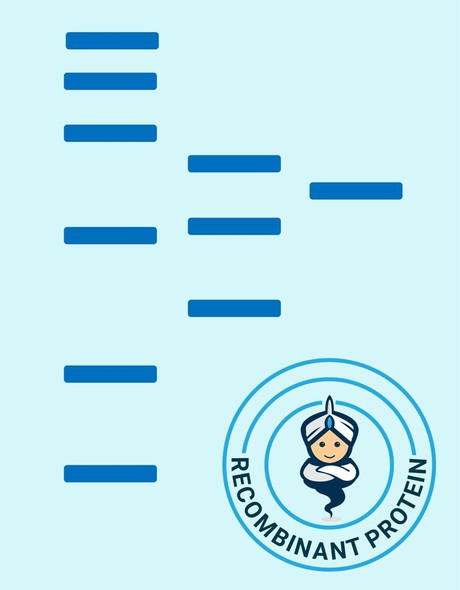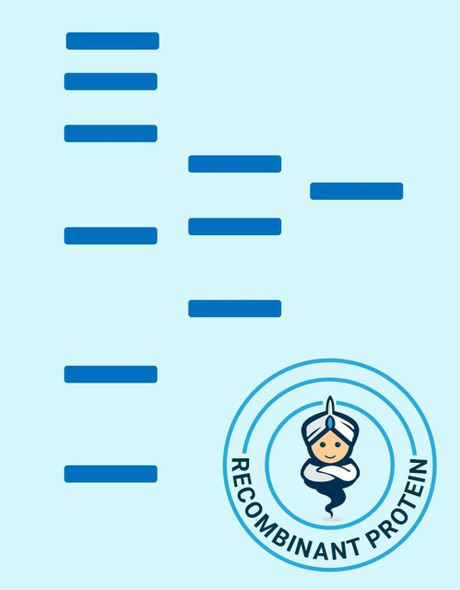Description
| Product Name: | Human BAG3 Recombinant Protein |
| Product Code: | RPPB2849 |
| Size: | 10µg |
| Species: | Human |
| Target: | BAG3 |
| Synonyms: | BIS, CAIR-1, BAG-3, BAG Family Molecular Chaperone Regulator 3, Bcl-2-associated athanogene 3, Bcl-2-binding protein Bis, Docking protein CAIR-1, BAG3, MGC104307. |
| Source: | Escherichia Coli |
| Physical Appearance: | Sterile filtered colorless solution. |
| Formulation: | The BAG3 protein contains 20mM Tris buffer pH-8, 1mM EDTA, 10% glycerol and 0.1mM PMSF. |
| Stability: | Store at 4°C if entire vial will be used within 2-4 weeks. Store, frozen at -20°C for longer periods of time. For long term storage it is recommended to add a carrier protein (0.1% HSA or BSA).Avoid multiple freeze-thaw cycles. |
| Purity: | Greater than 90% as determined by SDS-PAGE. |
| Amino Acid Sequence: | MGSSHHHHHH SSGLVPRGSH MSAATHSPMM QVASGNGDRD PLPPGWEIKI DPQTGWPFFV DHNSRTTTWN DPRVPSEGPK ETPSSANGPS REGSRLPPAR EGHPVYPQLR PGYIPIPVLH EGAENRQVHP FHVYPQPGMQ RFRTEAAAAA PQRSQSPLRG MPETTQPDKQ CGQVAAAAAA QPPASHGPER SQSPAASDCS SSSSSASLPS SGRSSLGSHQ LPRGYISIPV IHEQNVTRPA AQPSFHQAQK THYPAQQGEY QTHQPVYHKI QGDDWEPRPL RAASPFRSSV QGASSREGSP ARSSTPLHSP SPIRVHTVVD RPQQPMTHRE TAPVSQPENK PESKPGPVGP ELPPGHIPIQ VIRKEVDSKP VSQKPPPPSE KVEVKVPPAP VPCPPPSPGP SAVPSSPKSV ATEERAAPST APAEATPPKP GEAEAPPKHP GVLKVEAILE KVQGLEQAVD NFEGKKTDKK YLMIEEYLTK ELLALDSVDP EGRADVRQAR RDGVRKVQTI LEKLEQKAID VPGQVQVYEL QPSNLEADQP LQAIMEMGAV AADKGKKNAG NAEDPHTETQ QPEATAAATS NPSSMTDTPG NPAAP |
BAG3 Inhibits the chaperone activity of HSP70/HSC70 by promoting substrate release. BAG3 has anti-apoptotic activity. BAG proteins participate with Hip for their binding to Hsc70/Hsp70 ATPase domain and encourage substrate release. BAG proteins have about 45 amino acid BAG domain close to the C terminus however they differ noticeably in their N-terminal regions. BAG3 includes a WW domain in the N-terminal region and a BAG domain in the C-terminal region. The BAG domains of BAG1, BAG2, and BAG3 interact particularly with the Hsc70 ATPase domain in vitro and in mammalian cells. They bind with high affinity to the ATPase domain of Hsc70 and inhibit its chaperone activity in a Hip-repressible manner. BAG3 plays a role as a protein-refolding cochaperone of the bcl2 binding protein BAG family and as upregulated in response to persistent stress of cellular calcium balance dysregulation. BAG3 has been shown to diminish stress-induced apoptosis.
BAG3 Human Recombinant produced in E.Coli is a single, non-glycosylated polypeptide chain containing 595 amino acids (1-575 a.a.) and having a molecular mass of 63.7 kDa. The BAG3 protein is fused to a 20 amino acid His Tag at N-terminus and purified by standard chromatogrpahy techniques.
| UniProt Protein Function: | BAG3: Inhibits the chaperone activity of HSP70/HSC70 by promoting substrate release. Has anti-apoptotic activity. Defects in BAG3 are the cause of myopathy myofibrillar type 6 (MFM6). A neuromuscular disorder that results in early-onset, severe, progressive, diffuse muscle weakness associated with cardiomyopathy, severe respiratory insufficiency during adolescence, and a rigid spine in some patients. At ultrastructural level, muscle fibers display structural alterations consisting of replacement of the normal myofibrillar markings by small, dense granules, or larger hyaline masses, or amorphous material. Defects in BAG3 are the cause of cardiomyopathy dilated type 1HH (CMD1HH). CMD1HH is a disorder characterized by ventricular dilation and impaired systolic function, resulting in congestive heart failure and arrhythmia. Patients are at risk of premature death. |
| UniProt Protein Details: | Protein type:Apoptosis Chromosomal Location of Human Ortholog: 10q26.11 Cellular Component: cell-cell adherens junction; cytoplasm; cytosol; plasma membrane Molecular Function:adenyl-nucleotide exchange factor activity; protein binding Biological Process: induction of apoptosis via death domain receptors Disease: Cardiomyopathy, Dilated, 1hh; Myopathy, Myofibrillar, 6 |
| NCBI Summary: | BAG proteins compete with Hip for binding to the Hsc70/Hsp70 ATPase domain and promote substrate release. All the BAG proteins have an approximately 45-amino acid BAG domain near the C terminus but differ markedly in their N-terminal regions. The protein encoded by this gene contains a WW domain in the N-terminal region and a BAG domain in the C-terminal region. The BAG domains of BAG1, BAG2, and BAG3 interact specifically with the Hsc70 ATPase domain in vitro and in mammalian cells. All 3 proteins bind with high affinity to the ATPase domain of Hsc70 and inhibit its chaperone activity in a Hip-repressible manner. [provided by RefSeq, Jul 2008] |
| UniProt Code: | O95817 |
| NCBI GenInfo Identifier: | 12643665 |
| NCBI Gene ID: | 9531 |
| NCBI Accession: | O95817.3 |
| UniProt Secondary Accession: | O95817,Q3B763, Q9NT20, Q9P120, A8K5L8, |
| UniProt Related Accession: | O95817 |
| Molecular Weight: | 61,595 Da |
| NCBI Full Name: | BAG family molecular chaperone regulator 3 |
| NCBI Synonym Full Names: | BCL2 associated athanogene 3 |
| NCBI Official Symbol: | BAG3�� |
| NCBI Official Synonym Symbols: | BIS; MFM6; BAG-3; CAIR-1�� |
| NCBI Protein Information: | BAG family molecular chaperone regulator 3 |
| UniProt Protein Name: | BAG family molecular chaperone regulator 3 |
| UniProt Synonym Protein Names: | Bcl-2-associated athanogene 3; Bcl-2-binding protein Bis; Docking protein CAIR-1 |
| Protein Family: | BAG family molecular chaperone regulator |
| UniProt Gene Name: | BAG3�� |






